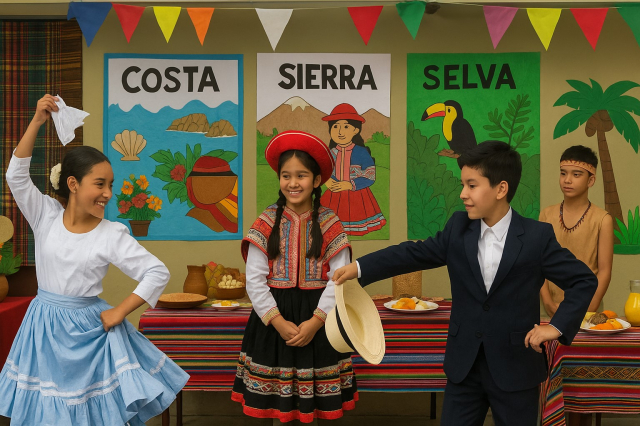Organizing a school cultural fair is one of the most enriching activities of the academic year in Peru. It allows students to learn about their country's customs, develop teamwork skills, and connect with the living history of each region. Below, we show you how to plan, organize, and present it successfully, with ideas adapted to Peruvian schools.
The importance of a cultural fair in school
School cultural fairs are more than just displays of dances or traditional dishes. They are spaces where students discover the value of Peruvian identity . Each exhibit, costume, or song becomes an opportunity to recognize the country's diversity and strengthen respect for different cultures.
In the Peruvian educational context, this activity also promotes skills in the areas of Personal Social, Communication, Art and Culture and can be easily integrated into the official school calendar of the MINEDU .
You can find more ideas for cultural activities on the CalendarioPeru.com blog.
Steps to organize a school cultural fair
1. Define the central theme of the fair
The first step is to choose a theme that connects with the school's context. Some examples:
“The regions of Peru” : ideal for showcasing the coast, highlands and jungle.
“Dances and traditions of Peru” : perfect for fairs in July or September.
“Typical foods of my region” : promotes gastronomy and culinary creativity.
“Pre-Hispanic Cultures of Peru” : very useful for history courses.
You can find inspiration in articles such as Typical Dances of Peru and their meaning or Regional Gastronomy of Peru .
2. Form working committees
Organize the students into teams with specific roles:
Decoration: prepare murals, flags, posters and ambiance.
Research: Gather information about regions, dances, or characters.
Presentations: rehearse dramatizations, dances, or oral presentations.
Gastronomy: coordinates the preparation of typical dishes or drinks.
This allows tasks to be distributed and fosters collaborative work.
3. Prepare a schedule of activities
The teacher or organizing committee must create a schedule with clear dates :
| Activity | Suggested date | Responsible |
|---|---|---|
| Choosing the topic | Week 1 | General Coordinator |
| Research and trials | Week 2-3 | Students and teachers guide |
| Decoration and preparation | Week 4 | Decoration Committee |
| Fair day | Week 5 | The entire educational community |
It is recommended to hold the fair between June and September , months in which many institutions celebrate National Holidays or school cultural weeks .
4. Prepare the materials and stands
Each group should have a representative space or stand. Here are some ideas:
Use blankets, ceramics, textiles, or musical instruments from each region.
Include maps of Peru , photos, or infographics created by the students.
Present handcrafted products or typical foods (these can be models if it is for beginner levels).
Tip: Recycling materials for decoration not only saves costs, but also promotes respect for the environment.
5. Rehearse cultural presentations
Before the event, it is recommended to conduct dress rehearsals to ensure good coordination.
Some ideas for presentations:
Typical dances: Marinera, Huayno, Festejo or Amazonian Gang.
Theatrical performances: stories of Manco Cápac and Mama Ocllo, the Independence of Peru or regional legends.
Gastronomic demonstrations: tastings or competitions of typical dishes.
These moments are ideal for parents and visitors to get involved and learn more about the country's traditions.
6. Promote the participation of the entire educational community
A cultural fair is more successful when it involves parents, teachers, students, and local authorities .
You can invite local folk groups, musicians or artisans, and even request support from the district municipality or the UGEL to broaden the event's reach.
7. Evaluate and share the results
After the fair, conduct a participatory evaluation :
What did the students learn?
What aspects can be improved next year?
Which booths were the most visited?
You can also upload photos and videos to social media or the school blog, highlighting the cultural and educational work.
If you want to know more ideal dates for school fairs, check the School Calendar in Peru .
Creative ideas for your school cultural fair
Innovative topics by region
Costa: Afro-Peruvian art and its influence on music.
Sierra: Andean textiles as cultural heritage.
Jungle: Amazonian biodiversity and traditions.
Lima: The migrant influence on the capital's gastronomy.
Additional activities
"Knowledge and Flavors of Peru" Contest.
Exhibition of traditional musical instruments .
Recycled traditional costume contest.
Intercollegiate dances with symbolic awards.
Benefits of holding a school cultural fair
It fosters national identity and pride in Peruvian roots.
Develops artistic and communicative skills in students.
It strengthens teamwork and empathy.
It promotes values of respect, creativity, and responsibility.
Furthermore, these types of projects can be presented as evidence of interdisciplinary learning to the MINEDU or during the annual pedagogical meeting.
